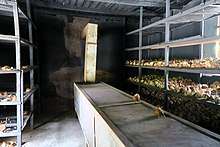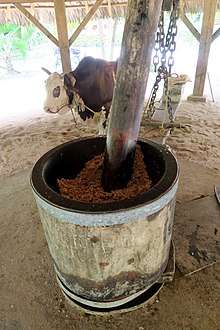Copra
Copra (or khobara) is the dried meat or kernel of the coconut, which is the fruit of the coconut palm (Cocos nucifera). Coconut oil is extracted from copra, making it an important agricultural commodity for many coconut-producing countries. It also yields de-fatted coconut cake after oil extraction, which is mainly used as feed for livestock.
Production
| Nutritional value per 100 g (3.5 oz) | |
|---|---|
| Energy | 354 kcal (1,480 kJ) |
24.23 (not the same as source listed) | |
| Sugars | 6.23 |
| Dietary fiber | 9 |
33.49 | |
3.33 g | |
| Vitamins | Quantity %DV† |
| Thiamine (B1) | 6% 0.066 mg |
| Riboflavin (B2) | 2% 0.02 mg |
| Niacin (B3) | 4% 0.54 mg |
| Pantothenic acid (B5) | 20% 1.014 mg |
| Vitamin B6 | 4% 0.05 mg |
| Vitamin C | 4% 3.3 mg |
| Minerals | Quantity %DV† |
| Calcium | 1% 14 mg |
| Iron | 19% 2.43 mg |
| Magnesium | 9% 32 mg |
| Phosphorus | 16% 113 mg |
| Potassium | 8% 356 mg |
| Zinc | 12% 1.1 mg |
| Other constituents | Quantity |
| Water | 47 |
| |
| †Percentages are roughly approximated using US recommendations for adults. Source: USDA Nutrient Database | |
Copra has traditionally been grated and ground then boiled in water to extract coconut oil. It was used by Pacific island cultures and became a valuable commercial product for merchants in the South Seas and South Asia in the 1860s. This 19th-century copra trading inspired Robert Louis Stevenson's 1893 novella The Beach of Falesá, based on his experiences in Samoa.[1] Nowadays, the process of coconut oil extraction is performed by crushing copra to produce coconut oil (70%); the by-product is known as copra cake or copra meal (30%).
Once the oil is extracted, the remaining coconut cake is 18–25% protein but contains so much dietary fiber it cannot be eaten in large quantities by humans. Instead, it is normally fed to ruminants.[2]


The production of copra – removing the shell, breaking it up, drying – is usually done where the coconut palms grow. Copra can be made by smoke drying, sun drying, or kiln drying. Hybrid solar drying systems can also be used to for a continuous drying process. In a hybrid solar drying system, solar energy is utilized during daylight and energy from burning biomass is used when sunlight is not sufficient or during night.[3] Sun drying requires little more than racks and sufficient sunlight. Halved nuts are drained of water, and left with the meat facing the sky; they can be washed to remove mold-creating contaminants. After two days the meat can be removed from the shell with ease, and the drying process is complete after three to five more days (up to seven in total). Sun drying is often combined with kiln drying, eight hours of exposure to sunlight means the time spent in a kiln can be reduced by a day and the hot air the shells are exposed to in the kiln is more easily able to remove the remaining moisture. This process can also be reversed, partially drying the copra in the kiln and finishing the process with sunlight. Starting with sun drying requires careful inspection to avoid contamination with mold while starting with kiln-drying can harden the meat and prevent it from drying out completely in the sun.
In India, small but whole coconuts can be dried over the course of eight months to a year, and the meat inside removed and sold as a whole ball. Meat prepared in this fashion is sweet, soft, oily and is cream-coloured instead of being white. Coconut meat can be dried using direct heat and smoke from a fire, using simple racks to suspend the coconut over the fire. The smoke residue can help preserve the half-dried meat but the process overall suffers from unpredictable results and the risk of fires.[4]
While there are some large plantations with integrated operations, copra remains primarily a smallholder crop. In former years copra was collected by traders going from island to island and port to port in the Pacific Ocean but South Pacific production is now much diminished, with the exception of Papua New Guinea, the Solomon Islands and Vanuatu.[5]
Economics
Copra production begins on coconut plantations. Coconut trees are generally spaced 9 m (30 ft) apart, allowing a density of 100–160 coconut trees per hectare. A standard tree bears around 50–80 nuts a year, and average earnings in Vanuatu (1999) were US$0.20 per kg (one kg equals 8 nuts)—so a farmer could earn approximately US$120 to US$320 yearly for each planted hectare. Copra has since more than doubled in price, and was quoted at US$540 per ton in the Philippines on a CIF Rotterdam basis (US$0.54 per kg) by the Financial Times on 9 November 2012.
In 2017 the value of global exports of copra was $145-146 Million. The largest exporter was Papua New Guinea with 35% of the global total, followed by Indonesia (20%), Solomon Islands (13%) and Vanuatu (12%). The largest importer of copra is the Philippines, which imports $93.4 Million or 64% of the global total.[5] A very large number of small farmers and tree owners produce copra, which is a vital part of their income.
Aflatoxin susceptibility
Copra is highly susceptible to the growth of molds and their production of aflatoxins if not dried properly. Aflatoxins can be highly toxic, and are among the most potent known natural carcinogens, particularly affecting the liver. Aflatoxins in copra cake, fed to animals, can be passed on in milk or meat, leading to human illnesses.
In the Philippines, copra is collected as dried "cups" (the meat from one-half of a coconut), which are shipped in large burlap (hessian) bags. At the shipping point (typically, a dock) the copra is sampled by driving a small metal tube into the bag at several points, thus perforating the cups and collecting small amounts of copra within the tubes. Those samples are measured for aflatoxin contamination. If within standards the bag is shipped. This method leaves the risk that many cups are missed by the random sampling—and seriously contaminated copra might be missed. Because so many small producers are involved, it is impractical to monitor all the farms and drying sites (which is where aflatoxin contamination occurs). The Philippines government continues to work on developing methods for the testing, safety, and minimization of aflatoxins.
Animal feed
Copra meal is used as fodder for horses and cattle. Its high oil and protein levels are fattening for stock.[6][7] The protein in copra meal has been heat treated and provides a source of high-quality protein for cattle, sheep and deer, because it does not break down in the rumen.
Coconut oil can be extracted using either mechanical expellers or solvents (hexane). Mechanically expelled copra meal is of higher feeding value, because it contains typically 8–12% oil, whereas the solvent-extracted copra meal contains only 2–4% oil. Premium quality copra meal can also contain 20–22% crude protein, and <20ppb aflatoxin.[8]
High-quality copra meal contains <12% non structural carbohydrate (NSC),[9] which makes it well suited for feeding to horses that are prone to ulcers, insulin resistance, colic, tying up, and acidosis.[10]
Shipment
Copra has been classed with dangerous goods due to its spontaneously combustive nature.[11] It is identified as a Division 4.2 substance. It has been forbidden by ICAO from flight without the express written permission of a state authorised agency.
References
- Holmes, LD (2001). Treasured Islands: Cruising the South Seas With Robert Louis Stevenson. Sheridan House. ISBN 1-57409-130-1.
- Grimwood, BE; Ashman, F; Dendy, DAV; Jarman, CG; Little, ECS; Timmins, WH (1975). Coconut Palm Products – Their processing in developing countries. Rome: FAO. p. 193. ISBN 978-92-5-100853-9.
- "Hybrid Solar Dryer for Copra". Copra Indonesia.
- Grimwood et al., 1975, p. 49–56.
- Simoes, AJG; Hidalgo, CA. "OEC: The Observatory of Economic Complexity". oec.world. The Observatory of Economic Complexity. Retrieved 17 December 2019.
- "Cocos nucifera". Fao.org. Retrieved 28 November 2012.
- "AFRIS – Animal feed Resources Information System". Fao.org. Retrieved 28 November 2012.
- "Nutrient Specs – Stance Equine". Stanceglobal.com.au. Archived from the original on 6 July 2011. Retrieved 28 November 2012.
- Archived 26 October 2009 at the Wayback Machine
- "CoolStance Benefits – Stance Equine". Stanceglobal.com.au. Archived from the original on 6 July 2011. Retrieved 28 November 2012.
- "Copra". Tis-gdv.de. Retrieved 28 November 2012.
External links
| Wikimedia Commons has media related to Copra. |
- Is Copra potentially a horse killer? – Horsetalk.co.nz
- Copra linked to cancer-causing agent
- Not all copra created equal
- Making Coconut Oil – The Old Chamorro Way
- AFLATOXIN CONTAMINATION IN FOODS AND FEEDS IN THE PHILIPPINES, in Manual on the application of the HACCP System in Mycotoxin prevention and ... , Food and Agriculture Organization of the United Nations.
- AFLATOXIN CONTAMINATION IN FOODS AND FEEDS IN THE PHILIPPINES, Food and Agriculture Organization of the United Nations.

